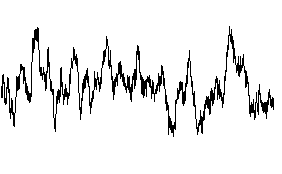
1. Paper Wads
When sheets of paper are wadded up into balls, the wadding process has the potential to create a fractal-like structure. That structure can be expected to produce a fractal dimension somewhere between 2 and 3.
Make a series five of tightly wadded balls of tissue paper (very un-stiff), five of typing paper (medium stiff), and five of brown paper bag paper (very stiff). Before making any measurements, guess which collection has the higher dimension. What reasons can you give to support your answer? In each case, collect 22 same size pieces of paper. From these, assemble five different sized pieces of paper to form the paper wads.
* Tape 16 together in a 4 x 4 arrangement.
* Tape 4 together in a 2 x 2 arrangement
* Take a single piece of paper
* Take the remaining piece of paper and cut it in half vertically and horizontally. Take one of the four pieces you get.
* Take another of the pieces you got in the previous step, cut it in half vertically and horizontally, and take one of these four pieces.
Crumple each to form a paper wad. Try to crumple all five in the same way. Let each set for a minute, measure its diameter in three different positions (try to get the longest diameter, the shortest diameter, and one in between) and compute the average diameter.
As described on pages 97-98 of the text, from largest to smallest these paper wads have N = 1, N = 4, N = 16, N = 64, and N = 256. To get the corresponding values of 1/s, divide the diameter of each wad into that of the largest. Tabulate the values of log(N) and log(1/s). Enter these into Cricket Graph and find the slope of the best-fitting line.
Were your guesses about dimension right or wrong? Try to relate your observed results to the physical properties of the different papers you used.
2. Tear Paths
When you tear a piece of paper, the tear path is rough and irregular. It writhes around in a way which is similar to a river or coastline. How close is that similarity?
Make a notch in the middle of one side of a piece of typing paper. Hold the sides of the paper firmly and pull them apart (in the plane of the paper) until the paper tears. The tear edge will be jagged and fractal-like. Overlay the torn edge on a piece of graph paper and estimate the dimension of the edge by box counting (like the river measurements described on pages 94-95). That is,
* Take a single square of graph paper as the unit: N = 1, 1/s = 1.
* Count the number of squares of graph paper the tear path intersects in a horizontal run of 10 squares. The number of squares you count is N, 1/s = 10.
* Count the number of squares of graph paper the tear path intersects in a horizontal run of 50 squares. The number of squares you count is N, 1/s = 50.
* Count the number of squares of graph paper the tear path intersects in a horizontal run of 100 squares. The number of squares you count is N, 1/s = 100.
* Tabulate the values of log(N) and log(1/s). Enter these into Cricket Graph and find the slope of the best-fitting line.
* Does the dimension depend on the speed with which the paper is torn?
* Try tissue paper and heavy packing paper instead of typing paper. Does the character of the edge depend on the structure of the paper? Compare your results with typical river and coastline dimensions.
Return to Labs